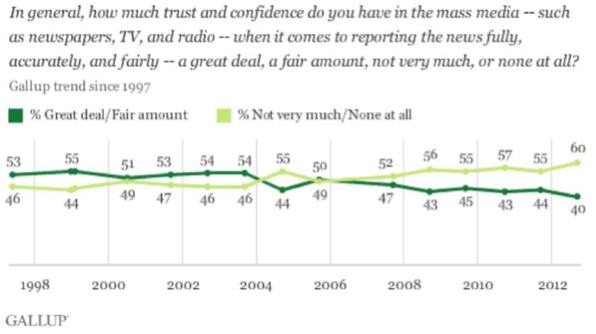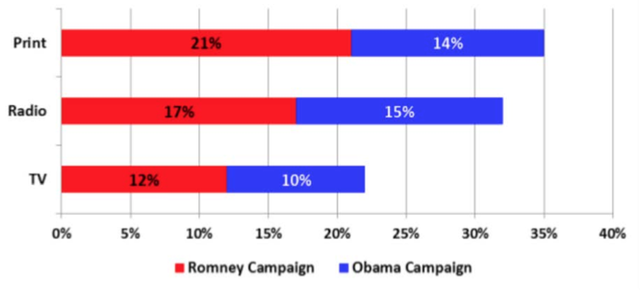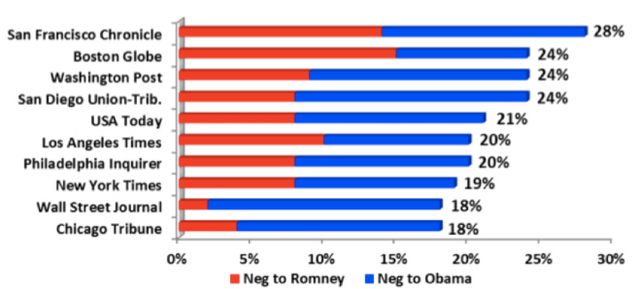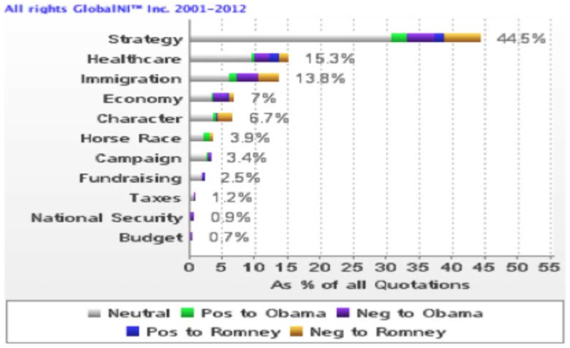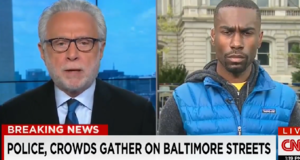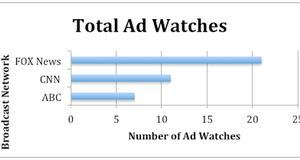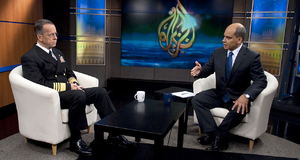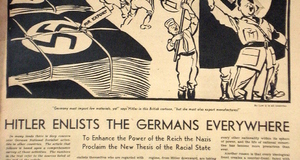From Elon Journal of Undergraduate Research in Communications VOL. 4 NO. 2Public Perceptions of Media Bias: A Meta-Analysis of American Media Outlets During the 2012 Presidential ElectionIV. ResultsImpact of Public Opinion on Media Bias PerceptionsStatistically speaking, the 2012 presidential election happened to occur during an era of American history that has been definitively characterized by the American public's mistrust in their elected government for the better part of a decade. Through a Gallup poll conducted September 6-9, 2011, public distrust toward all federally regulated institutions has progressively escalated to a new record high; sadly, American media outlets are no exception to this phenomenon. Survey figures from a 2011 poll released by Gallup indicate that public distrust of media is quickly reaching a new plateau. As depicted above in Figure 1, when polled "how much trust and confidence" they held toward mass media outlets, 55% of respondents reported "not very much" or "none at all" (Gallup Politics, 2012). This figure marks a 9 percentage increase from the reported 46% calculated in 1998 at the inception of the survey, as well as a 5 percentage increase from a reported 50% in 2005. Meanwhile, when polled about their perceptions of the potential existence of a liberal bias within the media, 47% stated their belief that the media is decidedly "too liberal," marking a considerable ideological disparity when compared to the 13% of respondents who identified the news media as being "too conservative." Meanwhile, 36% of respondents reported feeling that the media is "just about right" in terms of its ideological orientation. These can be further corroborated through analysis of the findings of a 2012 Pew Research Center survey, which calculates public distrust in media to have reached a historic level ("Pew, 2011"). Opposition to the mass media has reached the pinnacle of a 26-year growth spurt. The survey's findings indicated that 66% of survey respondents perceived news stories as "often inaccurate," marking a 32 percentage jump from a reported 34% in 1985. Meanwhile, 77% of respondents perceived the media to "tend to favor one side," marking a 24 percentage increase from a calculated 53% in 1985. Finally, 80% asserted their beliefs that the media is "often influenced by powerful people and organizations," illustrating a drastic 27 percentage increase from the previous 53% in 1985. Figure 1. Respondents were asked to convey their relative trust and/or approval of American media outlets ("Gallup Politics").
And yet, despite previous documented claims of liberal media bias, contemporary research profiling electoral coverage patterns does not coincide with popular belief. The data presented in Figure 2 indicates the Romney campaign boasted a greater percentage of electoral coverage than the Obama campaign across the print, radio and television mediums. On average, the Romney campaign was allotted 3% more statements in election coverage than the Obama campaign. The largest disparity in this trend can be observed through analysis of electoral print coverage, where Romney or members of his campaign staff held 6% more statements than Obama and his campaign officials did. Figure 2. This figure illustrates what percent of total campaign statements are offered from the Romney and Obama campaign officials through the print, television and radio mediums ("Romney Campaign Gets More Coverage Across Media Space," 2012).
Content Analysis: Major Print News outletsAnalysis of electoral print coverage points to a number of revelatory statistics regarding the perceptible ideological imbalance of partisan sentiments exemplified throughout the course of the election. Figure 3 suggests that amongst the top four syndicated print outlets depicted above, candidate Mitt Romney received a noticeably larger portion of total electoral coverage than President Barack Obama throughout the course of the campaign. Analysis of electoral coverage patterns exhibited by The New York Times, The Washington Post, and Los Angeles Times shows a 4:3 ratio in terms of overall space dedicated to Romney over Obama, thereby espousing almost double the number of campaign or issued-related statements coming from Mitt Romney than from Barack Obama. When it comes to Boston Globe electoral coverage, however, the pro-Romney coverage ratio drops to 2:1, a noticeable departure from the coverage patterns of the three aforementioned publications. The four print outlets depicted in Figure 3 represent the largest constituency of print consumers within the United States, thus offering the most encompassing representation available. Figure 3. This graph profiles the total percentage of electoral coverage dedicated to each candidate. All of the data here represents the collective assortment of news articles for these four publications within the sample timeline ("Candidate Coverage Among Top Print Outlets," 2012).
To get a conclusion from the print medium in general, other prominent American print outlets should be included in the study. Figure 4 illustrates the amount of positive coverage amplified by the 10 most patronized print outlets in the United States during the course of the election. Collectively, the 10 outlets referenced above allocated 22% of their overall electoral coverage to reflect negative sentiments about the candidates. These results also indicate showed that an average of 13% of statements in election coverage among four major print outlets could be viewed as positive in context. Amongst the 10 outlets rendered above, only 14% of their total dedicated election coverage was perceived to reflect a positive context and tone; this value highlights an 8% gap compared to the amount of negative coverage. As depicted in Figure 4, only 3 out of 10 newspapers printed less percentage of negative statements against Obama than Romney.
Figure 4 shows percent of negative statements out of total coverage among the top ten print outlets in the United States ("Negative Coverage Among Top Print Outlets" 2012).
Content Analysis: Major Television News OutletsThis part will feature a coordinated meta-analysis of the issue-specific coverage patterns of American broadcasting networks (namely, in this instance, network and cable television). The evaluation system this paper relies on is created by 4thEstate.net (whose data the author will also feature) as "Voiceshare." It encapsulates each candidate's respective share of the total dedicated electoral coverage across all major news mediums. Any statement is said by a candidate or campaign officials, about them, one point is assigned to the candidate, raising his or her total Voiceshare percentage. Print and television outlets covered the 2012 election differently. While the former predominantly tailored their electoral coverage to reporting on candidates policy initiatives and advocacy of relevant social issues, the latter seemed to consciously downplay the candidates' respective policy stances in favor of placing added emphasis on campaign strategy and professional decorum. Figure 5 illustrates that electoral television coverage lacks considerable policy-related discussion in comparison to its print counterpart. About 45% of all broadcast sentiments were oriented around discussions of each candidates respective campaign strategies. By comparison, the most heavily discussed policy issue featured in electoral television coverage related to the ongoing universal healthcare debate (more popularly known as Obamacare), representing a mere 15% of analyst statements. This pattern reflects a conscious effort by American broadcast outlets to place particular emphasis on critiquing candidate image and campaign developments over policy initiatives. In addition, 30% of statements made by featured analysts and commentators throughout all television election coverage on campaign strategy have been partisan-influenced, whilst the remaining 70% majority had been viewed as non-partisan or neutral toward Romney and Obama. This final statistic is particularly unexpected within the context of televised electoral coverage, as the broadcast format is more commonly associating with several of the previously discussed forms of biased reporting from which the public identifies bias. For the overwhelming majority of statistics pertaining to broadcast statements to indicate a minority of partisan sentiments (especially in regard to such subjective facets of a presidential campaign like campaign strategy and perceptions of professional decorum) helps concretize the author's previous assertion that modern journalists strive to uphold the tenets of objectivity and fair, neutral reporting in spite of the public stigmatization of their profession. Figure 5. This chart illustrates the percentage of statements from analysts and commentators in television coverage of the election, categorized by topic ("Election Coverage on TV Lacks Substance," 2012). Suggested Reading from Inquiries Journal
Inquiries Journal provides undergraduate and graduate students around the world a platform for the wide dissemination of academic work over a range of core disciplines. Representing the work of students from hundreds of institutions around the globe, Inquiries Journal's large database of academic articles is completely free. Learn more | Blog | Submit Latest in Business & Communications |

